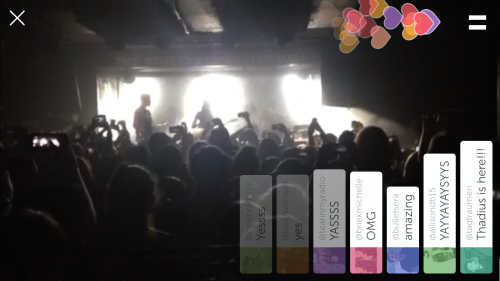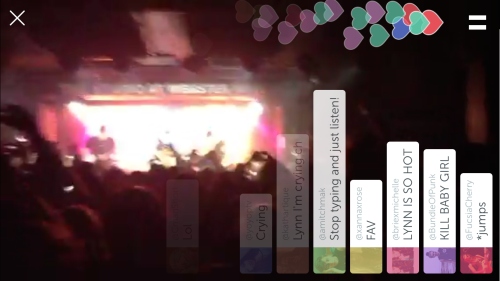Livecasting: What You Can Learn From Watching Pvris Perform At Webster Hall On Periscope
With the seemingly unstoppable growth being experience by the market for apps allowing you to broadcast your life in real time it should come as no surprise that artists have found yet another way to connect with their fans in the digital space.
Guest Post by James Shotwell on The Official Blog of Haulix
Last night, in front of hundreds of fans, Rise Records group Pvris became one of the first internationally-recognized bands in the world to share their thrilling live show with fans around the globe in real time, for free, using nothing more than a cell phone and an app they downloaded for free from iTunes.
We told you back in late March about Periscope and the numerous ways musicians could leverage the real-time mobile broadcast platform to benefit their careers. At the time, we never imagined a mainstream artist would consider sharing a straightforward live performance given the many issues such promotions would face in regards to assuring a quality broadcast (sound, lighting, etc.). but last night Pvris rolled the dice and more or less came out victors as a result. The image wasn’t great, and to be honest the audio did leave a bit to be desired, but the broadcast allowed the band’s many fans around the world a new way to connect with the group, as well as one another, that was equally unique and fleeting (Periscope deletes all broadcasts twenty-four hours after a recording is first made).
If you missed the broadcast entirely, there is no way to share it with you now. You cannot embed broadcasts, and even if you could the app captures all broadcasts as vertical video. Viewers watching Pvris had to hold their phones sideways to view the concert proper, but if they did that it became a bit more difficult to keep track of the fan-generated conversation happening simultaneously on the same screen. Here’s an example:

The entire broadcast lasted only through the opening song of the band’s set, and even that proved to be a bit difficult. Connection was never lost, but at one point whoever was responsible for holding or watching the phone capturing the performance lost control of the device and the image became incredibly hard to watch:

This may sound like a lot of complaining, but I actually think this event was a great success. Pvris’ broadcast was far from perfect, but it did manage to teach us a few things:
1. Periscope would be wise to implement a horizontal/widescreen broadcast setting.
Vertical video syndrome used to be a pretty hilarious meme, but the age of cell phone broadcasting has made its use more prevalent than ever before. Due to the way Periscope has been developed, the chat functions do not rotate with the camera during a broadcast so, as you see above, users are forced to choose between engaging with others and strictly viewing the performance. There is also no way to shut off the chat (at least not one that is clearly marked on screen), so it’s possible to foresee instances where the interaction between audience members takes away from the action on screen.
2. Despite a lack of HD video and studio quality sound, fans stuck around to view the entire performance.
The initial Pvris broadcast brought in 558 viewers, with an additional 276 people watching the video replay of the performance in the hours since the live feed came to an end. I watched the video twice myself, and though I won’t claim to have been able to read every comment that flew by on screen, I did not see a single person complain about the video or audio quality of the event. Most fans were just excited to have the opportunity to see the band live at all, with numerous people commenting “This may be the closest I ever get to seeing you,” or “This makes up for me not being allowed to see you on Warped Tour this summer.”
3. Artists hoping to duplicate this idea in the future would be wise to invest in a tripod.
I mentioned this briefly above, but it became increasingly clear as the Pvris broadcast continued that there was someone holding the phone capturing the performance. While they did their job perfectly fine, numerous moments of shakiness and one instance where the view of the band was lost entirely due to circumstances that remain unclear may have been avoided if the phone/iPad/etc running Periscope had been placed in a tripod or similar device that enabled stabilized recording.
4. Fan-filmed broadcasts of concerts large and small will be on the rise in no time at all, so artists might as well take the lead.
Unless Periscope develops a way for quote/unquote ‘celebrities’ to broadcast in full HD, the level of quality recording attainable for anyone using Periscope is basically the same. The Pvris broadcast, while far from perfect, proved people will engage with the platform in spite of not having the best audio or video to enjoy. The access the platform gives those without the means to attend events is second to none, and it will only be a matter of time before every other teen at every date of Warped Tour is capturing full sets from bands for people online to enjoy from the comfort of their own home. Maybe they’ll be broadcasting for a friend who wasn’t allowed to attend, or maybe they’ll be broadcasting in hopes of getting some digital recognition for being the ‘first’ to share the group’s latest live show. Whatever the case, Periscope’s foray into the world of live music has only just begun.
With that in mind, I think it’s important for artists to follow the lead of Pvris and begin using Periscope to share their own live performances and behind-the-scenes antics. Let fans know now, while the app is still young, that your official account is the best source for broadcasts featuring you and your music. You could also encourage fans to share videos of your performance using a specific hashtag that helps further your brand.
5. It never hurts to try something new
Pvris on Periscope could have been a complete disaster. The sound at Webster Hall could have overwhelmed the phone’s micropohone, or the lighting at the venue could have made the video too much of a colorful mess to enjoy, but instead the band’s first real-time performance broadcast was proof the emerging social media platform could be used to connect with fans in a new way. It’s not perfect yet, but it will almost certainly be approved upon, and for the time being it’s more than good enough to capture and retain the attention of the band’s global fanbase, many of whom are likely in high school or college.
6. Pvris are a really, really great band.
Part of the reason nobody seemed to care that the audio from Webster Hall wasn’t crystal clear is because Pvris still sounded great. The band has been praised by critics and fans alike for their tight live show, and even a low quality real-time broadcast of their set could not diminish the talent they have developed through years of hard work and constant dedication. The less than ideal setup may have exposed another band’s lack of cohesion on stage, but for Pvris it was only further proof this still young band has an incredibly bright future on the horizon.
James Shotwell is the Marketing Coordinator for Haulix. He is also a professional entertainment critic, covering both film and music, as well as the co-founder ofAntique Records. Feel free to tell him you love or hate the article above by connecting with him on Twitter. Bonus points if you introduce yourself by sharing your favorite Simpsons character.
You can turn off comments easily just below the video before you start playing it or when you pause and go back.